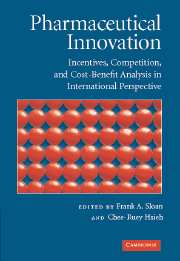 Pharmaceutical Innovation
Pharmaceutical Innovation Published online by Cambridge University Press: 18 December 2009
Introduction
To decide on the allocation of public and private resources, some form of cost-effectiveness analysis is used in many countries, large and small (Drummond, Chapter 11). The single most common type of medical care to which this method is applied is the use of pharmaceutical products. Sometimes the decision involves new uses for existing products developed and produced in the country making the decision, and sometimes it involves products imported from abroad. Sometimes as well the decision involves the potential allocation of resources to a new product if brought to market, and often public funds play a role in such innovation.
In this chapter I criticize existing cost-effectiveness studies of pharmaceuticals, many of which, given their stated perspective, use an incorrect measure of cost and consequently, if the results were followed, would lead to inefficient resource allocation decisions, distort the mix of funds for research, and reduce population health. Although I acknowledge there is no single answer to the question of the right cost figure to use, I indicate that deciding which conceptual setting matches the decision in question is often not easy and often made incorrectly. Some consequences of using the conceptually correct methods may raise some difficult political questions, but those questions will yield better answers if there is agreement in advance on what framework and measures to use and how decisions are to be based on this information.
I develop a general argument about correct measurement.
To save this book to your Kindle, first ensure [email protected] is added to your Approved Personal Document E-mail List under your Personal Document Settings on the Manage Your Content and Devices page of your Amazon account. Then enter the ‘name’ part of your Kindle email address below. Find out more about saving to your Kindle.
Note you can select to save to either the @free.kindle.com or @kindle.com variations. ‘@free.kindle.com’ emails are free but can only be saved to your device when it is connected to wi-fi. ‘@kindle.com’ emails can be delivered even when you are not connected to wi-fi, but note that service fees apply.
Find out more about the Kindle Personal Document Service.
To save content items to your account, please confirm that you agree to abide by our usage policies. If this is the first time you use this feature, you will be asked to authorise Cambridge Core to connect with your account. Find out more about saving content to Dropbox.
To save content items to your account, please confirm that you agree to abide by our usage policies. If this is the first time you use this feature, you will be asked to authorise Cambridge Core to connect with your account. Find out more about saving content to Google Drive.